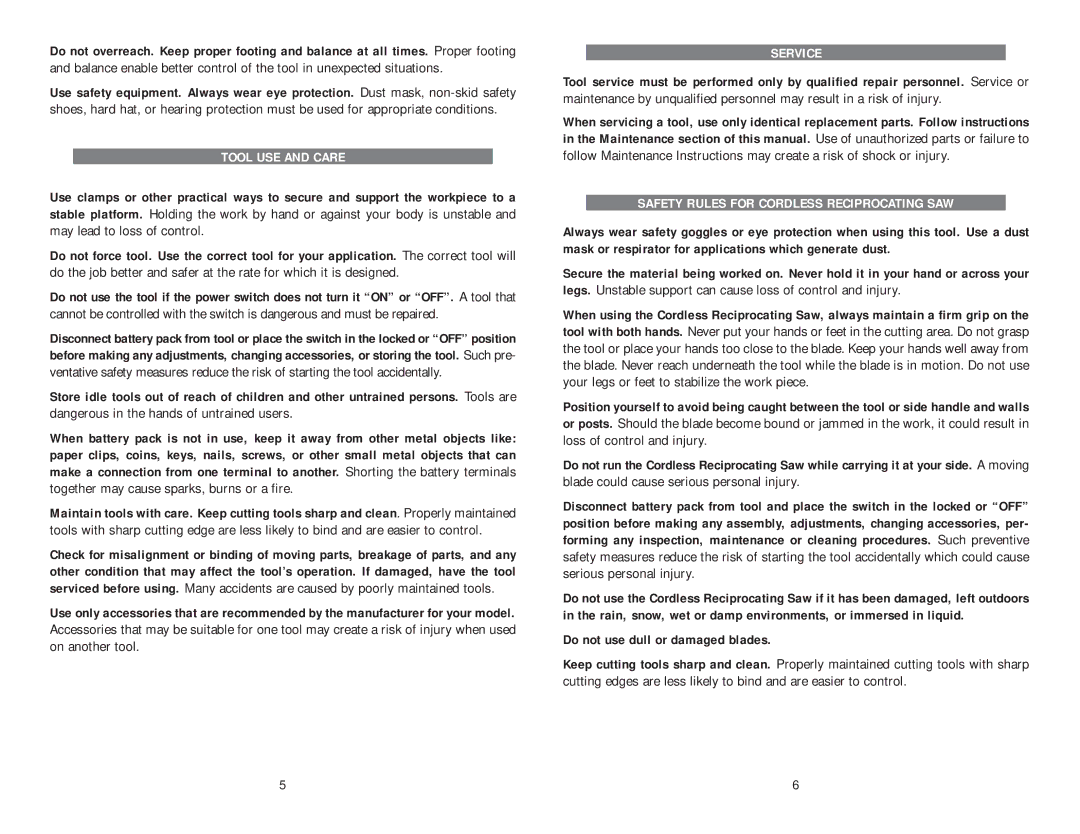
Do not overreach. Keep proper footing and balance at all times. Proper footing and balance enable better control of the tool in unexpected situations.
Use safety equipment. Always wear eye protection. Dust mask,
TOOL USE AND CARE
Use clamps or other practical ways to secure and support the workpiece to a stable platform. Holding the work by hand or against your body is unstable and may lead to loss of control.
Do not force tool. Use the correct tool for your application. The correct tool will do the job better and safer at the rate for which it is designed.
Do not use the tool if the power switch does not turn it “ON” or “OFF”. A tool that cannot be controlled with the switch is dangerous and must be repaired.
Disconnect battery pack from tool or place the switch in the locked or “OFF” position before making any adjustments, changing accessories, or storing the tool. Such pre- ventative safety measures reduce the risk of starting the tool accidentally.
Store idle tools out of reach of children and other untrained persons. Tools are dangerous in the hands of untrained users.
When battery pack is not in use, keep it away from other metal objects like: paper clips, coins, keys, nails, screws, or other small metal objects that can make a connection from one terminal to another. Shorting the battery terminals together may cause sparks, burns or a fire.
Maintain tools with care. Keep cutting tools sharp and clean. Properly maintained tools with sharp cutting edge are less likely to bind and are easier to control.
Check for misalignment or binding of moving parts, breakage of parts, and any other condition that may affect the tool’s operation. If damaged, have the tool serviced before using. Many accidents are caused by poorly maintained tools.
Use only accessories that are recommended by the manufacturer for your model. Accessories that may be suitable for one tool may create a risk of injury when used on another tool.
SERVICE
Tool service must be performed only by qualified repair personnel. Service or maintenance by unqualified personnel may result in a risk of injury.
When servicing a tool, use only identical replacement parts. Follow instructions in the Maintenance section of this manual. Use of unauthorized parts or failure to follow Maintenance Instructions may create a risk of shock or injury..
SAFETY RULES FOR CORDLESS RECIPROCATING SAW
Always wear safety goggles or eye protection when using this tool. Use a dust mask or respirator for applications which generate dust.
Secure the material being worked on. Never hold it in your hand or across your legs. Unstable support can cause loss of control and injury.
When using the Cordless Reciprocating Saw, always maintain a firm grip on the tool with both hands. Never put your hands or feet in the cutting area. Do not grasp the tool or place your hands too close to the blade. Keep your hands well away from the blade. Never reach underneath the tool while the blade is in motion. Do not use your legs or feet to stabilize the work piece.
Position yourself to avoid being caught between the tool or side handle and walls or posts. Should the blade become bound or jammed in the work, it could result in loss of control and injury.
Do not run the Cordless Reciprocating Saw while carrying it at your side. A moving blade could cause serious personal injury.
Disconnect battery pack from tool and place the switch in the locked or “OFF” position before making any assembly, adjustments, changing accessories, per- forming any inspection, maintenance or cleaning procedures. Such preventive safety measures reduce the risk of starting the tool accidentally which could cause serious personal injury.
Do not use the Cordless Reciprocating Saw if it has been damaged, left outdoors in the rain, snow, wet or damp environments, or immersed in liquid.
Do not use dull or damaged blades.
Keep cutting tools sharp and clean. Properly maintained cutting tools with sharp cutting edges are less likely to bind and are easier to control.
5 | 6 |
